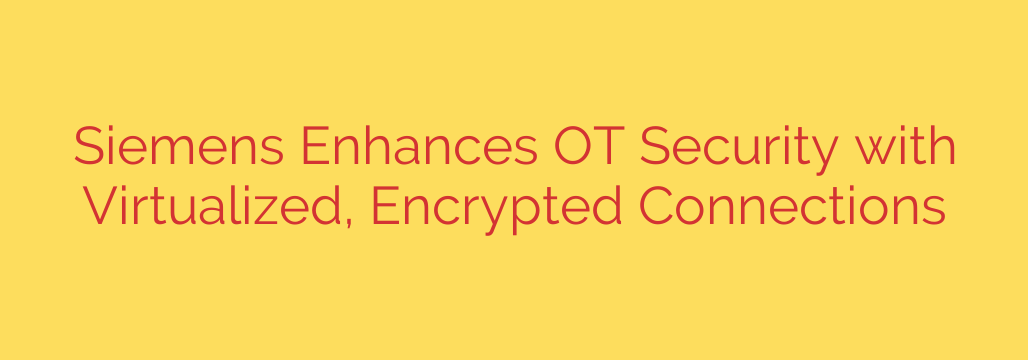
Securing Industrial Networks: The Power of Virtualized and Encrypted Connections
The line between information technology (IT) and operational technology (OT) is blurring faster than ever. While this convergence unlocks new efficiencies, it also exposes critical industrial control systems (ICS) to unprecedented cyber threats. Protecting the factory floor is no longer about building a digital wall; it requires a sophisticated, dynamic defense strategy. A groundbreaking approach is emerging, one that leverages virtualization and end-to-end encryption to create a resilient and secure industrial environment.
The Evolving Threat to Operational Technology
For decades, OT networks—the systems that manage physical processes in manufacturing, energy, and utilities—were isolated or “air-gapped” from the outside world. Security was an afterthought because physical separation was the primary defense. Today, the demand for remote monitoring, predictive maintenance, and data analytics has connected these sensitive systems to corporate networks and the internet, making them a prime target for cyberattacks.
The challenge is that traditional IT security solutions often don’t translate well to the OT world. Industrial systems prioritize uptime and safety above all else, often relying on legacy hardware and protocols that cannot be easily patched or updated. This is where a modern security architecture becomes essential.
A New Paradigm: Virtualized Security on the Edge
Instead of relying on a single, centralized firewall, the future of OT security lies in distributing and embedding security functions directly where they are needed. This is achieved through virtualization on industrial-grade hardware.
Imagine a powerful local processing platform, like the Siemens Scalance LPE, sitting on the edge of your network. This single piece of hardware can run a virtualized security appliance, acting as a robust cell protection firewall. This software-defined approach offers several key advantages:
- Granular Network Segmentation: By deploying virtual firewalls, you can divide your production network into smaller, isolated security zones. If one area is compromised, the breach can be contained, preventing it from spreading across the entire plant floor.
- Reduced Hardware Footprint: A single processing engine can host the security functions that once required multiple physical devices. This saves valuable cabinet space, reduces energy consumption, and simplifies hardware management.
- Flexibility and Scalability: As your security needs evolve, you can easily update or deploy new virtual appliances without needing to install new hardware. This makes the entire system more adaptable to future threats.
The Critical Role of Encrypted Connections
Connecting to industrial assets remotely is a necessity for modern operations, but it’s also a major security risk if not handled correctly. Simply opening a port is an invitation for attackers. The solution is to ensure every remote connection is authenticated, authorized, and fully encrypted.
This is where a centralized remote access management platform becomes invaluable. A system like Sinema Remote Connect provides a secure bridge for remote users, service technicians, and even entire production sites. Here’s how it works:
- Secure VPN Tunnels: All data is transmitted through end-to-end encrypted VPN (Virtual Private Network) tunnels. This ensures that even if the data were intercepted, it would be unreadable to unauthorized parties.
- Centralized User Management: Administrators have a single point of control to grant or revoke access rights. This means you can provide a specific technician with temporary access to a single machine, and that access is automatically terminated after the work is complete.
- Simplified, Secure Connections: The platform manages the complex process of establishing secure connections, eliminating the need for manual configuration and reducing the risk of human error. Technicians can connect securely with just a few clicks, without needing deep IT security expertise.
Actionable Steps to Bolster Your OT Security
Protecting your industrial network is an ongoing process, not a one-time fix. Here are some essential steps to improve your security posture:
- Conduct a Comprehensive Asset Inventory: You cannot protect what you don’t know you have. Map out every device on your OT network, including PLCs, HMIs, and sensors.
- Implement Robust Network Segmentation: Use firewalls—whether physical or virtual—to create protected zones around your most critical assets. Restrict communication between zones to only what is absolutely necessary.
- Secure All Remote Access Points: Eliminate unauthorized remote access methods. Mandate the use of a centrally managed, encrypted VPN solution for all maintenance and monitoring activities.
- Develop a Patch Management Strategy: While patching in OT can be challenging, it is not impossible. Create a plan to test and deploy security patches in a way that minimizes disruption to operations.
- Train Your Personnel: The human element is often the weakest link. Ensure both IT and OT staff are trained on cybersecurity best practices and understand their roles in protecting the facility.
By embracing modern solutions like virtualization and encrypted remote access, organizations can build a defense-in-depth strategy that protects critical infrastructure without sacrificing the connectivity needed for a competitive, modern operation.
Source: https://www.helpnetsecurity.com/2025/10/01/siemens-sinec-secure-connect/








